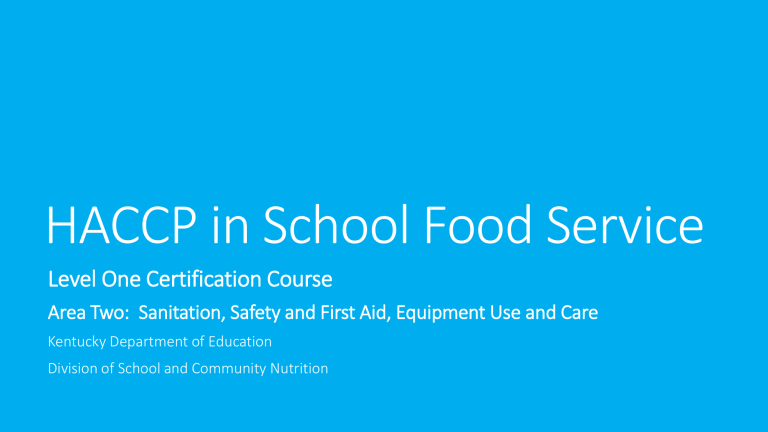
HACCP in School Food Service
Level One Certification Course
Area Two: Sanitation, Safety and First Aid, Equipment Use and Care
Kentucky Department of Education
Division of School and Community Nutrition
Course Objectives
From this presentation food service staff should be able to:
- Understand why food safety is needed;
- Understand the principles of HACCP;
- Utilize HACCP principles.
Introduction
It is extremely important that all food service staff have a full understanding of the
importance of safety and sanitation in the food service area.
Area Two of the Level One Certification course will look at the many aspects of safety
and sanitation that are involved in not only keeping students safe, but food service
staff as well.
What is HACCP?
Serving safe food is a critical responsibility for school food service.
The Hazard Analysis Critical Control Point (HACCP) is a systematic approach to food
safety.
The program is designed to reduce the risk of food-borne hazards by focusing on each
step of the food preparation process, from receiving to service.
When properly implemented, HACCP based safety programs will help ensure the
safety of school meals served to children.
HACCP is required by the USDA.
HACCP for Food Service Staff
A good food safety plan becomes part of
the normal routine for all staff!
Why should we be concerned with food
safety in school foodservice?
Children are a “high risk” population for
foodborne illnesses.
Food is handled by many different
individuals and/or companies.
Microorganisms, known or unknown, can
be very dangerous and spread quickly.
HACCP- What does the H.A. mean?
The H (Hazard) and A (Analysis) in HACCP deal with identifying any physical, chemical
and biological hazards that can contaminate food.
For example: Does your food service staff wear hair nets or visors? If yes, then that
practice is part of your food safety plan! The hair net or visor helps to prevent objects
such as hair or hair clips from contaminating food.
Other possible hazards found could be:
Physical: toothpicks, fingernails, earrings, metal screws, hair, etc.
Chemical: aerosol, pest controls, sanitizers, cleaning supplies
Biological: harmful microorganisms
HACCP- What does the C.C.P. mean?
The second part of the HACCP plan
is to identify critical control points.
Critical Control Points help to
identify when foods pass through
the Danger Zone.
CCP’s can be found on standardized
recipes.
These “CCPs” indicate important steps in how food is handled in foodservice to prevent, eliminate, or reduce a food
safety hazard to an acceptable level.
CCP’s and Temperature Logs
Always follow established routine
procedures for documenting
temperatures for foods,
refrigerators, freezers, etc. Also,
look for an action plan on what to
do if the temperature is out of the
required range and in the danger
zone.
Be sure to take action to avoid any
food contamination issues.
Be sure to…
Check with your food service manager or food service director on specific HACCP
related procedures that are in place at your work site.
It is of vital importance that all food service staff know and understand HACCP
procedures to ensure the safety of the food served from the school lunch program!
Thank you!
“The U.S. Department of Agriculture (USDA) prohibits discrimination
against its customers, employees, and applicants for employment on
the bases of race, color, national origin, age, disability, sex, gender
identity, religion, reprisal, and where applicable, political beliefs, marital
status, familial or parental status, sexual orientation, or if all or part of
an individual's income is derived from any public assistance program, or
protected genetic information in employment or in any program or
activity conducted or funded by the Department. (Not all prohibited
bases will apply to all programs and/or employment activities.)
If you wish to file a Civil Rights program complaint of discrimination,
complete the USDA Program Discrimination Complaint Form, found
online at http://www.ascr.usda.gov/complaint_filing_cust.html, or at
any USDA office, or call (866) 632-9992 to request the form. You may
also write a letter containing all of the information requested in the
form. Send your completed complaint form or letter to us by mail at
U.S. Department of Agriculture, Director, Office of Adjudication, 1400
Independence Avenue, S.W., Washington, D.C. 20250-9410, by fax (202)
690-7442 or email at program.intake@usda.gov.
Individuals who are deaf, hard of hearing or have speech disabilities
may contact USDA through the Federal Relay Service at (800) 877-8339;
or (800) 845-6136 (in Spanish).
USDA is an equal opportunity provider and employer.”
